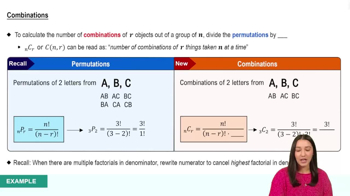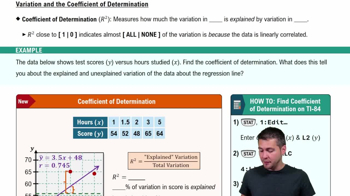Pick 10 Lottery For the New York Pick 10 lottery, the player first selects 10 numbers from 1 to 80. Then there is an official drawing of 20 numbers from 1 to 80. The prize of $500,000 is won if the 10 numbers selected by the player are all included in the 20 numbers that are drawn. Find the probability of winning that prize.
Table of contents
- 1. Intro to Stats and Collecting Data1h 14m
- 2. Describing Data with Tables and Graphs1h 55m
- 3. Describing Data Numerically2h 5m
- 4. Probability2h 16m
- 5. Binomial Distribution & Discrete Random Variables3h 6m
- 6. Normal Distribution and Continuous Random Variables2h 11m
- 7. Sampling Distributions & Confidence Intervals: Mean3h 23m
- Sampling Distribution of the Sample Mean and Central Limit Theorem19m
- Distribution of Sample Mean - Excel23m
- Introduction to Confidence Intervals15m
- Confidence Intervals for Population Mean1h 18m
- Determining the Minimum Sample Size Required12m
- Finding Probabilities and T Critical Values - Excel28m
- Confidence Intervals for Population Means - Excel25m
- 8. Sampling Distributions & Confidence Intervals: Proportion1h 12m
- 9. Hypothesis Testing for One Sample3h 29m
- 10. Hypothesis Testing for Two Samples4h 50m
- Two Proportions1h 13m
- Two Proportions Hypothesis Test - Excel28m
- Two Means - Unknown, Unequal Variance1h 3m
- Two Means - Unknown Variances Hypothesis Test - Excel12m
- Two Means - Unknown, Equal Variance15m
- Two Means - Unknown, Equal Variances Hypothesis Test - Excel9m
- Two Means - Known Variance12m
- Two Means - Sigma Known Hypothesis Test - Excel21m
- Two Means - Matched Pairs (Dependent Samples)42m
- Matched Pairs Hypothesis Test - Excel12m
- 11. Correlation1h 6m
- 12. Regression1h 50m
- 13. Chi-Square Tests & Goodness of Fit1h 57m
- 14. ANOVA1h 57m
4. Probability
Counting
Problem 3.4.9
Textbook Question
In Exercises 7-14, perform the indicated calculation.
9.8C3
 Verified step by step guidance
Verified step by step guidance1
Step 1: Understand the problem. The notation 9.8C3 represents a combination calculation, where we are selecting 3 items from a total of 9.8 items. The formula for combinations is given by: , where n is the total number of items, r is the number of items to choose, and '!' denotes factorial.
Step 2: Substitute the values into the formula. Here, n = 9.8 and r = 3. The formula becomes: .
Step 3: Simplify the denominator. Calculate (n - r), which is 9.8 - 3 = 6.8. The denominator now becomes: .
Step 4: Factorials for non-integer values like 9.8! and 6.8! are calculated using the Gamma function, which extends the factorial function to real numbers. You would use a calculator or software capable of handling Gamma functions to compute these values.
Step 5: Divide the result of 9.8! by the product of 3! and 6.8! to find the combination value. Ensure all calculations are performed accurately using appropriate tools.
 Verified video answer for a similar problem:
Verified video answer for a similar problem:This video solution was recommended by our tutors as helpful for the problem above
Video duration:
2mPlay a video:
Was this helpful?
Key Concepts
Here are the essential concepts you must grasp in order to answer the question correctly.
Combinations
Combinations refer to the selection of items from a larger set where the order of selection does not matter. The notation 'nCr' or 'C(n, r)' represents the number of ways to choose 'r' items from 'n' items. This concept is crucial in probability and statistics, especially when determining possible outcomes in scenarios where arrangement is irrelevant.
Recommended video:

Combinations
Factorial
A factorial, denoted as 'n!', is the product of all positive integers up to 'n'. It is used in combinations and permutations to calculate the total arrangements of a set. For example, 5! equals 5 × 4 × 3 × 2 × 1 = 120. Understanding factorials is essential for performing calculations involving combinations and permutations.
Recommended video:

Combinations
Binomial Coefficient
The binomial coefficient, often represented as 'C(n, r)' or 'nCr', quantifies the number of ways to choose 'r' elements from a set of 'n' elements without regard to the order of selection. It is calculated using the formula C(n, r) = n! / (r!(n-r)!), which incorporates factorials. This concept is fundamental in combinatorial mathematics and probability theory.
Recommended video:
Guided course

Coefficient of Determination

 7:11m
7:11mWatch next
Master Introduction to Permutations with a bite sized video explanation from Patrick
Start learningRelated Videos
Related Practice
Textbook Question
